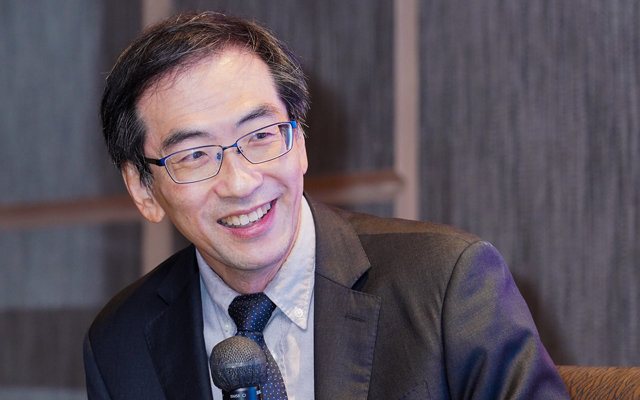Sia Kheng Yok, chief executive of the Association of Aerospace Industries (Singapore), talks about how the association creates neutral grounds to discuss and explore safety, security, or sustainability ideas, as well as share best practices and innovative solutions for the betterment of the industry

What are your day-to-day duties as chief executive of Association of Aerospace Industries (Singapore) (AAIS)?
AAIS represents Singapore-based companies involved in aviation, aerospace, and unmanned aircraft systems (UAS). We serve as the voice of the industry, engaging with government and regulators on future directions and policies, facilitating business, and engendering the industry community.
As chief executive reporting to the management committee, my role is primarily to lead and organise the AAIS team to support Singapore’s aviation and aerospace hub and serve the needs of industry and members. This involves developing and executing strategies; building connections and networks; and engaging members, partners, government agencies and the media.
With the pandemic not quite over, how did the association keep its members engaged and provide assistance for challenges that emerged during the pandemic?
When the pandemic first hit, we focused on responding to the immediate needs and challenges of our members, facilitating business and operational continuity, and engaging with the government on support for jobs, staff and industry. We sharpened our role as interlocutors between industry and government agencies and projected the industry’s collective voice.
In this respect, I think we have done well collectively to retain capabilities and the capacity in Singapore to ramp up quickly in response to renewed demand as aviation recovers.
As the pandemic lingered, it became clear that the industry would not be able to return to pre-pandemic business as usual. We recognised the need to chart a new course to prepare for a changed post-pandemic landscape. Our members acted, too, gearing up for the future by encouraging innovation, implementing digitalisation, skills upgrading, and sustainability initiatives.
AAIS jointly undertook a study with the Singapore Economic Development Board (EDB), contributing to the Aerospace Industry Transformation Map (ITM) 2025. The ITM is a national industry plan that plots a growth path for the industry, guiding us as we head into full recovery and beyond.
Why is it necessary to take part in events like inter airport Southeast Asia (IASEA) 2023?
Events like IASEA 2023 (held March 1 to 3, 2023) provide an important platform for our members and the wider industry to showcase their capabilities and connect with potential customers. AAIS coordinated the Singapore Pavilion at this event and collaborated with the organisers on curating the conference. This was an opportunity for Singapore companies and AAIS members to engage international participants on market developments in the South-east Asian region.
The next IASEA will be in two years, from March 25 to 27, 2025.
What does an airport of the future look like to you, and how is the industry driving efficacies in Singapore and beyond?
Airports in Asia-Pacific have undergone significant changes accelerated by the pandemic. Virtually all airports had to introduce health and safety measures to protect travellers and staff, such as temperature checks, mask-wearing, and enhanced cleaning protocols. Many trimmed their workforce as aviation ground to a virtual standstill, but now face manpower shortages in recovery.
With the re-opening of borders in Asia, airports are ramping up. However, it is not all business as usual. Decarbonisation will be a core theme in the ongoing transformation of air hubs.
In Singapore, the Civil Aviation Authority of Singapore is planning the launch of a sustainability blueprint to guide a carbon-neutral growth path for Singapore’s aviation sector. To encourage regional collaboration on decarbonisation, the ASEAN Transport Working Group convened a Sustainability Forum in September 2022. It adopted the Terms of Reference of the ASEAN Sustainable Aviation Action Plan that seeks to promote sustainable aviation growth in ASEAN, with a focus on Sustainable Aviation Fuel (SAF).
For improved airport processes and new technology, let me cite Singapore’s Changi Airport as an example. To improve efficiency, and enhance passenger experience and biosafety, Changi Airport has implemented several new technologies, building on its digitalisation and innovation momentum. Some examples are the automated immigration clearance system that uses facial recognition technology to verify passengers’ identities, contactless check-in that allows passengers to scan their boarding passes and passports without touching any surfaces, and robotic cleaners that use sensors and cameras to navigate, clean and even sanitise airport terminals.
Other technologies are being explored at Changi’s airside to improve efficiency and safety, including the Advanced Visual Docking Guidance System, which uses lasers and cameras to guide aircraft to their gates, reducing the risk of collisions and improve efficiency, and Automated Guided Vehicles to transport baggage between terminals and aircraft.
Looking to the future, we can expect that airports will continue incorporating new technologies such as artificial intelligence and machine learning to optimise airport operations, enhance efficiency, and improve the passenger experience.
What are the biggest challenges out there with airports around the region all at different stages of digitalisation and modernisation?
There is a varying degree of digitalisation and modernisation across different countries and airports in the Asia-Pacific region. This can create a lack of consistency in the passenger experience and challenges for airlines and airport operators who need to navigate different systems and processes.
The pandemic has highlighted the need for streamlined health and safety management, as varying airport procedures caused confusion and inconvenience for passengers. There is room to address the harmonisation of such processes.
Airports can prioritise interoperability, guided by organisations like the International Civil Aviation Organisation (ICAO), for example, allowing passports to be accepted with different biometric identification technologies.
Passenger traffic in the Asia-Pacific is expected to grow six-fold by 2050 (according to Airports Council International, December 2022), creating countless opportunities for inbound travel and revenue streams from passengers and airlines.
On the other hand, it may also pressure airport infrastructure and capacity, which will be more challenging for smaller airports or those in less economically developed countries to address. Not all airports have access to the same technologies and resources, so collaborative efforts will be beneficial. South-east Asia, for example, welcomed the adoption of the ASEAN Guidelines on Airport Environmental Management System to promote a regional approach to airport environmental management systems in achieving sustainable aviation.
What are some of your plans for AAIS and where do you think the association will be in five years?
Over the next five years, AAIS plans to continue supporting innovation and sustainability in Singapore’s aviation, aerospace and UAS industries.
Towards this end, we are working hard on sharpening our value proposition and broadening our services to cater to the needs of a broader membership base. In tandem with our members, we will develop our digital, analytical and service capabilities. We will continue to evolve and adapt to meet the changing needs of our members and the industry, while working closely with stakeholders to build a vibrant, innovative and sustainability-driven ecosystem for aviation in Singapore.
Do you think achieving net-zero for the aviation industry is possible by 2050?
The path to net-zero will not be easy. Still, each positive step in reducing emissions can improve operational efficiency, make the industry more resilient to climate-related risks, and signal to governments, customers and other stakeholders that the industry is committed to responsible growth for the long term.SAF, new propulsion technologies, and other efficiency improvements, such as improvements to air traffic navigation, are considered the most promising ways to reduce emissions at the source in the aviation industry.
The International Air Transport Association (IATA) estimates that SAF can account for around 65 per cent of the necessary emissions. However, they are currently three to four times more expensive than traditional jet fuels due to small production runs.
Aircraft and engine manufacturers have been incrementally improving existing technology to reduce emissions, including more efficient engines, better aerodynamics, and reduced weight. Geared turbofan engines and further design advances are expected to achieve 15 to 25 per cent fuel efficiency improvements over the next two decades.
In the 2030s, we can expect technological readiness for even more revolutionary propulsion technologies and advanced designs, such as hybrid electric, fully electric, and hydrogen-powered aircraft. However, the latter may be in the more distant future.
In the near term, we expect the most progress in mitigating carbon from Carbon Offsetting and Reduction Scheme for International Aviation (CORSIA), and the gradual ramping up of SAF supply. Feedstock supply remains a significant bottleneck and SAF prices are high relative to jet fuel. But producers are starting to invest in refining capacity. Neste, a Finnish oil refining company with a refinery and regional headquarters in Singapore, has invested €1.5 billion (US$1.7 billion) to expand its Singapore operations, which will soon have the capacity to produce up to one million tonnes of SAF annually.











